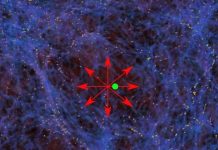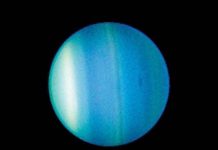
At the center of the more-massive galaxies in the Universe lie the intensely powerful and energetic phenomena known as supermassive black holes (SMBHs).
This includes the SMBH at the center of the Milky Way, the mysterious radio source known as Sagittarius A*.
The presence of these black holes causes the nuclei of these galaxies to become particularly energetic – aka., an Active Galactic Nucleus (AGN), or a Quasar – and causes them to outshine all of the other stars in the galactic disk combined.
For decades, astronomers have sought to learn more about SMBHs and their role in the evolution of the cosmos.
A particularly burning question is how early SMBHs formed in the Universe, which would place constraints on how they have influenced galaxies over time.
In a surprising discovery, an international team observed the ancestor of an SMBH for the first time. This black hole (known as GNz7q) existed during a period known as “Cosmic Dawn,” far earlier than expected.
The team was led by postdoctoral student Seiji Fujimoto and Prof. Gabriel Brammer of the Cosmic Dawn Center (DAWN), a collaborative effort between the University of Copenhagen’s (UCPH) Niels Bohr Institute and DTU Space.
They were joined by researchers from the Technical University of Denmark (DTU), the Max Planck Institute for Astronomy (MPIA), the Astronomical Observatory of Rome, the European Southern Observatory (ESO), Steward Observatory, Geneva Observatory, the Institute de Radio Astronomie Millimétrique, and the National Radio Astronomy Observatory (NRAO).
As they indicate in their paper, GNz7q was discovered based on the NASA/ESA Hubble Space Telescope data. Based on their analysis, the object had properties that lay somewhere between those of a galaxy and those of a quasar.
This led them to conclude that the object was the predecessor of an SMBH that existed over 13 billion years ago, just 750 million years after the Big Bang. This coincides with the period known as “Cosmic Dawn,” when the first galaxies in the Universe formed.
While previously-conducted simulations that modeled cosmic expansion have indicated that such objects existed during this era, this is the first time any such object was observed. Said Fujimoto, a postdoctoral fellow based at the Niels Bohr Institute, in a recent UCPH press release:
“The discovered object connects two rare populations of celestial objects, namely dusty starbursts and luminous quasars, and thereby provides a new avenue toward understanding the rapid growth of supermassive black holes in the early universe.”
This potential ancestor of an SMBH was discovered as part of the Hubble GOODS North (GOODS-N) field survey, one of the largest panoramic views of the early Universe in the ultraviolet spectrum.
This survey featured approximately 15,000 galaxies, 12,000 of which were observed to have high rates of star formation. One of these was GNz7q, which was visible as a red point source thanks to Hubble‘s far-ultraviolet (UV) imaging capabilities and slitless spectroscopy.
Further analysis indicated it is extremely faint in terms of X-rays, indicating a uniquely ultraviolet compact star-forming region or a black-hole accretion disk at the dusty starburst core.
The team concluded that the observed properties were consistent with predictions made by the aforementioned cosmological simulations used to recreate the life-cycle of galaxies and quasars. It further suggests that GNz7q is ancestrally-related to quasars observed in more recent cosmic epochs.
Interestingly enough, GNz7q was found at the center of the Hubble GOODS-N, which happens to be one of the most intensely-studied survey fields.
The team was only able to notice it “hiding in plain sight” because of the survey’s richly-detailed multi-wavelength datasets. Without these, the object would have easily gone unnoticed since it lacks the distinguishing features that had quasars during the early epochs of the Universe.
“This shows how big discoveries can often be hidden right in front of you,” said Bammer. It’s unlikely that discovering GNz7q within the relatively small GOODS-N survey was just “dumb luck,” but rather that the prevalence of such sources may, in fact, be significantly higher than previously thought.”
The discovery is linked to a certain type of quasars (quasi-stellar objects), specifically those that have very high rates of star formation and dust at the center.
With older quasars, such as those observed closer to the Milky Way, their brightness results from SMBHs causing vast amounts of gas to fall into orbit around them at relativistic speeds (a fraction of the speed of light).
As the gas infalls towards the outer edge of the black hole (the Event Horizon), it heats up due to intense friction and releases tremendous amounts of energy as light and heat.
In contrast, young galaxies with high rates of star formation near their nuclei cause them to release intense heat and cosmic dust.
This dust absorbs light from around the SMBH, causing the quasar to glow brightly in the infrared spectrum.
In the case of GNz7q, the rate of new stars forming is 1,600 times greater than the Milky Way galaxy, making it more luminous in the IR spectrum than any known object that existed during this period of Cosmic Dawn. As Brammer explained:
“Understanding how supermassive black holes form and grow in the early universe has become a major mystery.
Theorists have predicted that these black holes undergo an early phase of rapid growth: a dust-reddened compact object emerges from a heavily dust-obscured starburst galaxy, then transitions to an unobscured luminous compact object by expelling the surrounding gas and dust.”
“Although luminous quasars had already been found even at the earliest epochs of the universe, the transition phase of rapid growth of both the black hole and its star-bursting host had not been found at similar epochs. Moreover, the observed properties are in excellent agreement with the theoretical simulations and suggest that GNz7q is the first example of the transitioning, rapid growth phase of black holes at the dusty star core, an ancestor of the later supermassive black hole.”
Looking ahead, the team hopes to rely on the James Webb Space Telescope (JWST) to systematically search for similar objects.
Between its high-resolution optics and sophisticated suite of infrared cameras and spectrometers, the James Webb will be able to look ever farther back in time and see the earliest galaxies when they were still forming.
This will give astronomers the ability to see exactly how galaxies and the large-scale structure of the Universe have evolved ever since. As Fujimoto summarized:
“Fully characterizing these objects and probing their evolution and underlying physics in much greater detail will become possible with the James Webb Telescope. Once in regular operation, Webb will have the power to decisively determine how common these rapidly growing black holes truly are.”
The James Webb will be joined by other next-generation instruments in the coming years, including space-based telescopes like NASA’s Nancy Grace Roman (RST) and Spectro-Photometer for the History of the Universe, Epoch of Reionization and Ices Explorer (SPHEREx) space telescopes, and the ESA’s Euclid, Athena, and Atmospheric Remote-sensing Infrared Exoplanet Large-survey (ARIEL) missions.
Concurrently, ground-based instruments like the ESO’s Extremely Large Telescope, the Giant Magellan Telescope, and the Thirty Meter Telescope (TMT) will also become operational.
Relying on a combination of advanced optics, adaptive optics, coronographs, and spectrometers, these observatories will look back to the beginning of the Universe, revealing new insights into Dark Matter, Dark Energy, and cosmic evolution.
At long last, the cosmic “Dark Ages” that have prevented astronomers from studying the earliest periods of the Universe will finally be dispelled.
The paper that describes their research and findings recently appeared in the scientific journal Nature. Be sure to check out this animation of what it would be like to zoom in on GNz7q, courtesy of Hubble ESA:
Written by Matt Williams.
Source: Universe Today.



